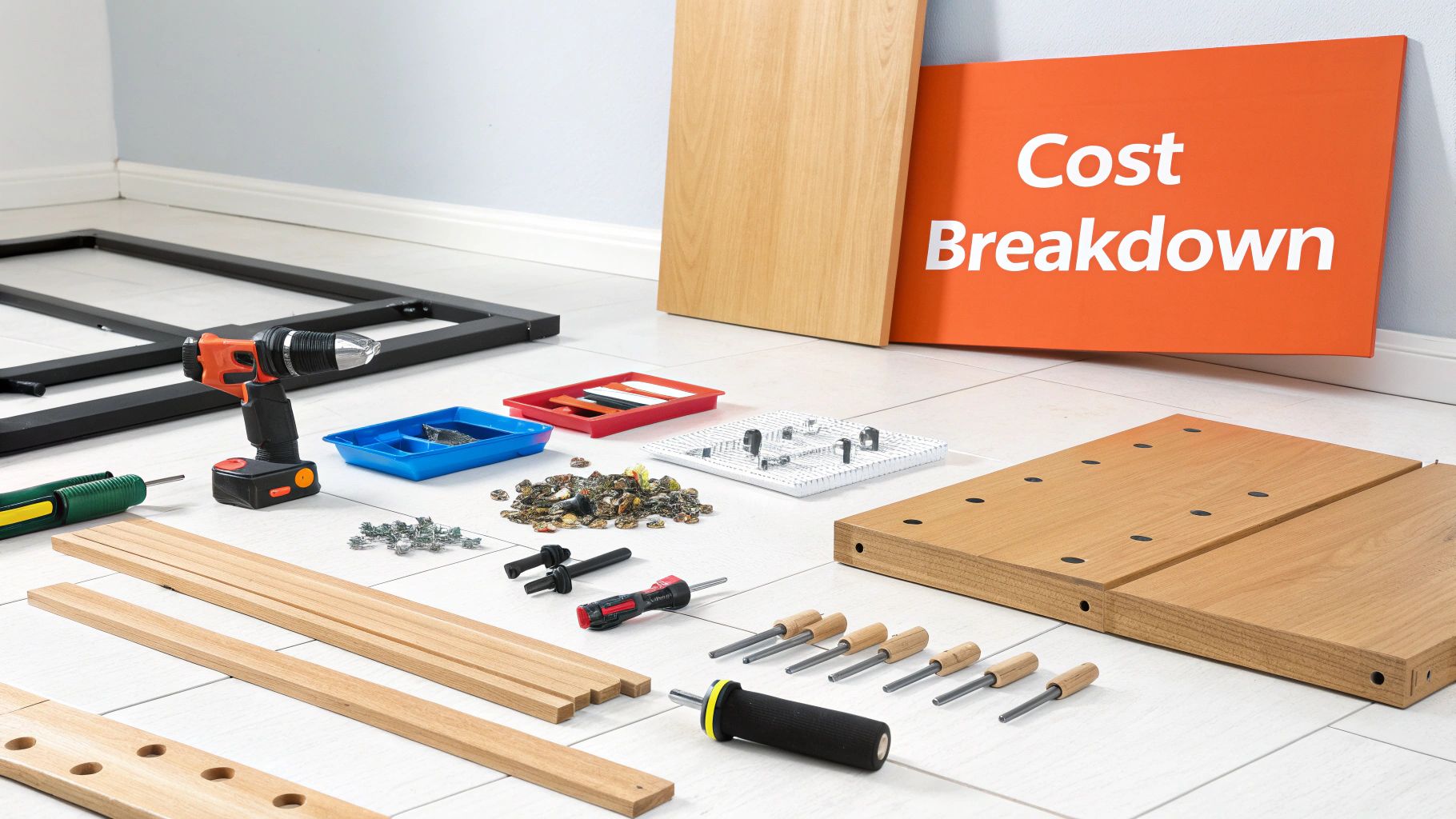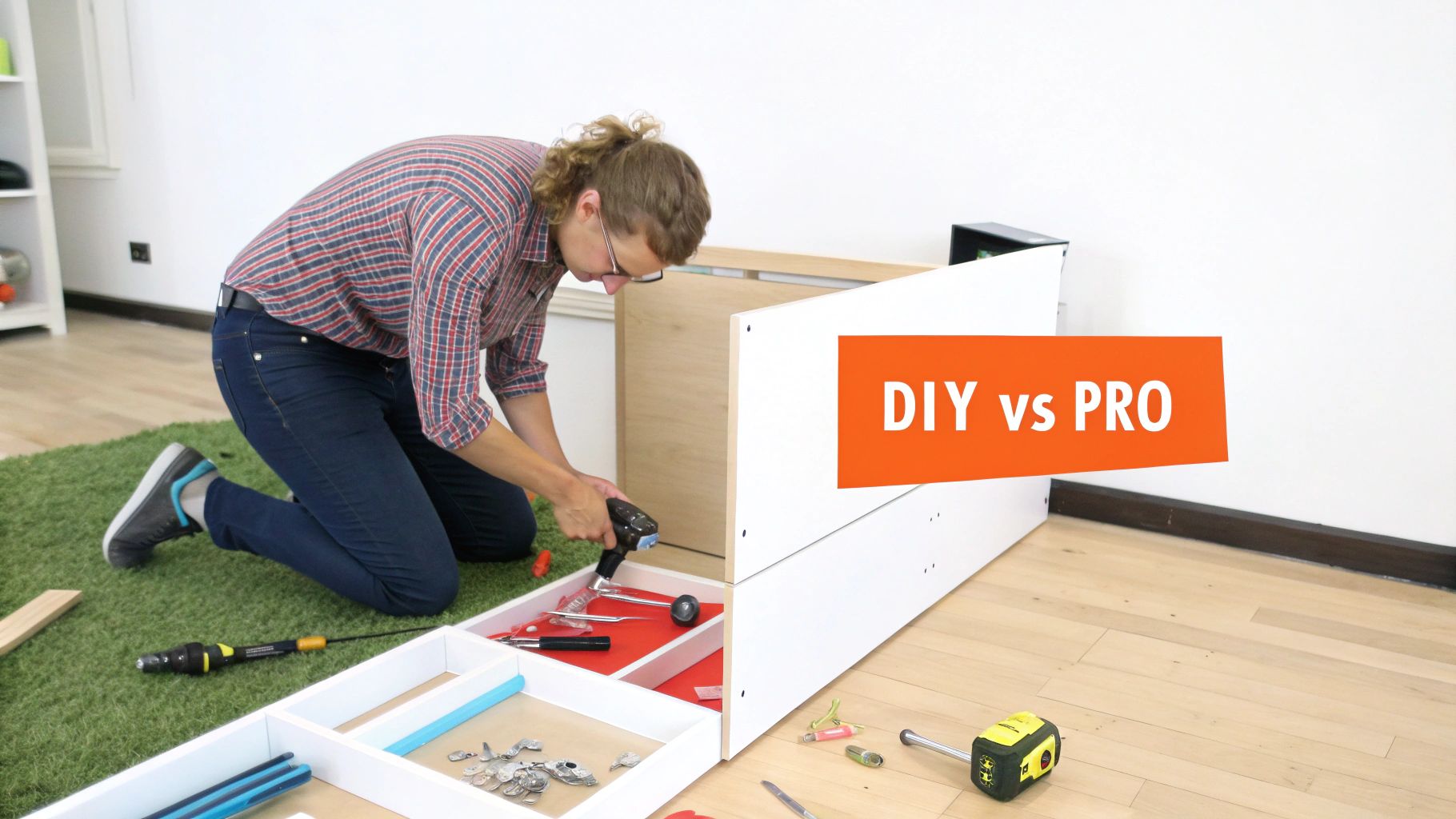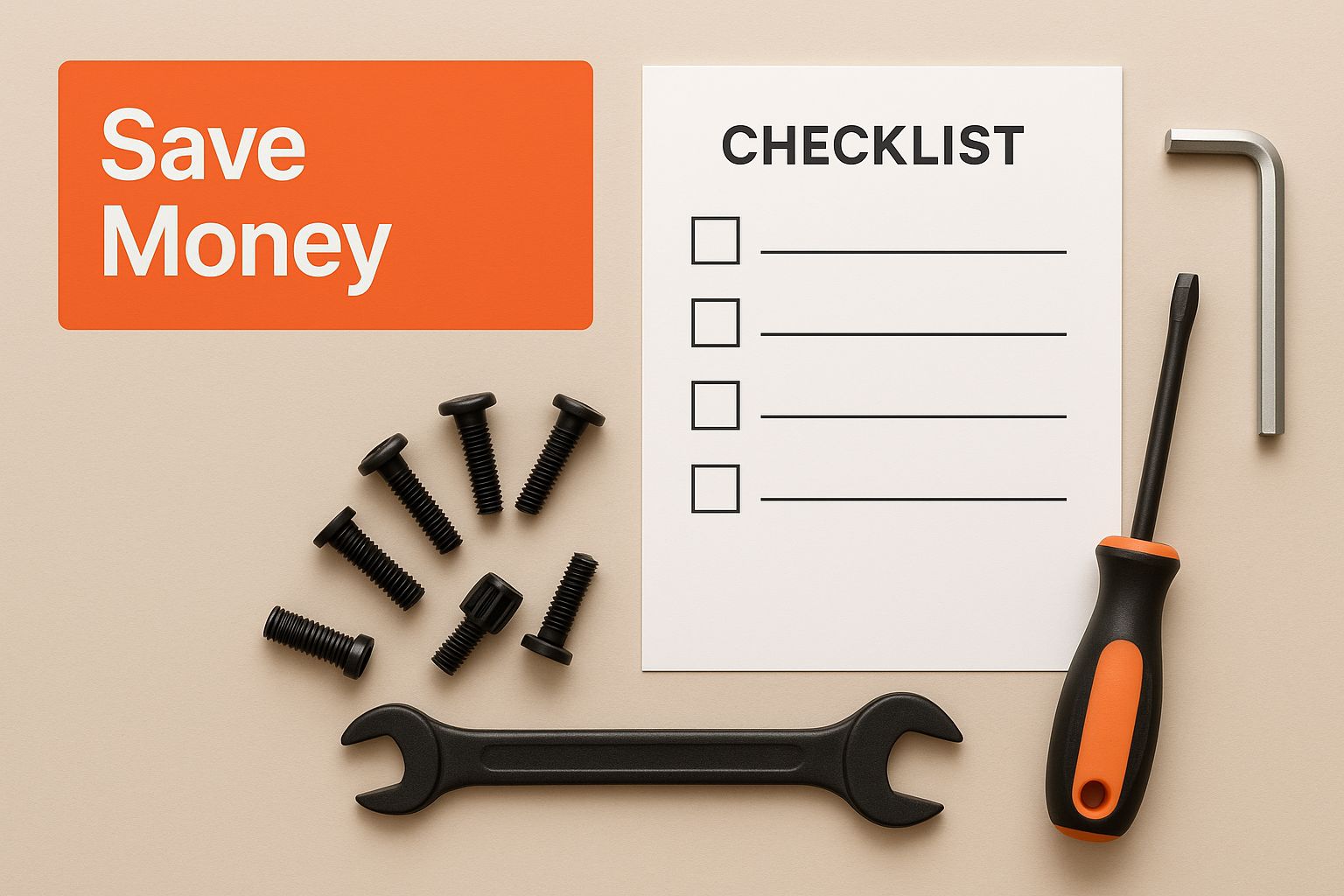-
CALL US:
- (866) 952-3456
You've brought home the flat-pack boxes, and now you're staring at a pile of particleboard, a bag of mysterious hardware, and a wordless instruction manual. The big question looms: what's it actually going to cost to turn this into a functional piece of furniture?
The truth is, hiring a pro for IKEA assembly can run you anywhere from $50 to over $500. It all depends on what you're building. A simple KALLAX shelf is on the low end of that scale, but a massive PAX wardrobe system or a full kitchen installation? That's a different story entirely.

Let's get right to it. You need a number to budget, but the answer isn't a simple one-size-fits-all price tag. IKEA’s famous flat-pack model keeps costs down by having you do the work, but let’s be honest—many of us would rather pay someone to save our time and sanity.
Assembly services have a wide range of prices, mostly because the furniture itself varies so much in complexity, and labor costs change depending on where you live.
For a basic bookshelf, an experienced assembler might be done in 30 minutes. In most major cities, you can expect to pay somewhere between $50 and $100 for a small job like that. On the other hand, a more involved piece, like a multi-drawer dresser or a bed frame, can take several hours, pushing the assembly cost well over $200 for a single item.
To give you a clearer picture, we've put together a quick look at the typical professional assembly costs for some of IKEA's best-sellers. Think of this as a starting point for your budget.
| IKEA Product | Estimated Assembly Time | Estimated Cost Range (USD) |
|---|---|---|
| KALLAX Shelving Unit | 30 – 60 minutes | $50 – $100 |
| HEMNES 8-Drawer Dresser | 2 – 3.5 hours | $120 – $210 |
| MALM Bed Frame (Queen) | 1 – 2 hours | $80 – $160 |
| PAX Wardrobe System | 3 – 8+ hours | $200 – $600+ |
Keep in mind, these numbers are solid estimates, but your final bill will depend on the exact configuration you chose and any extra services you might need, like wall-mounting or adding custom lighting.
The pricing logic is pretty similar to other installation jobs. If you want to dig deeper into how these costs break down, checking out the average cost to install cabinets can give you a good frame of reference. For an even broader look at the industry, you can explore our complete guide to furniture assembly service costs.

Figuring out the final IKEA furniture assembly cost is a little like trying to predict the weather—you can’t just look at one number. While an hourly rate or a per-item price gives you a starting point, several key factors can swing your final quote, turning what looks like a simple job into a more involved project.
The most obvious driver is how complex the furniture is. Let’s be real: putting together a simple LACK side table is a completely different world from building a HEMNES eight-drawer dresser. More parts, tricky steps, and delicate pieces like glass doors or drawers on runners all demand more time and skill, which will naturally be reflected in the price.
Your location plays a surprisingly big role in the cost. Labor rates in a major city like New York or Chicago are just going to be higher than in a smaller town. An assembler in a high-cost-of-living area might charge 15-25% more for the exact same job, simply to cover their own business expenses.
A professional's time is the core product you're buying. Anything that saves them time—like having a clear workspace—will directly save you money. Conversely, anything that adds time, like custom modifications, will increase the cost.
On top of that, the sheer volume of work makes a difference. Hiring a pro for a single chair can feel pricey because of minimum service fees, but bundling several items into one appointment is way more cost-effective. Many assemblers offer a discounted rate for booking them for a half-day or a full day, which brings the per-item cost way down.
Other common things that can add to your bill include:
Knowing about these variables helps you set a more realistic budget from the get-go. To see how all these pieces fit together, check out the detailed breakdown of general furniture assembly cost we've put together on our blog.
You made it through the IKEA maze, loaded up the car, and now you’re home, staring at a pile of flat-pack boxes. This is the moment of truth. Do you roll up your sleeves and tackle it yourself, or do you call in a pro? The real IKEA furniture assembly cost isn't just about the money; it’s measured in your time, your sanity, and whether that new PAX wardrobe will actually stand up straight.
The DIY route is, without a doubt, the cheapest option on paper. You're not paying for labor, after all. But there are hidden costs—your entire Saturday, the slow-burning frustration of trying to make sense of wordless instructions, and the very real risk of a wobbly bookcase because one tiny screw went in the wrong place. When deciding, it's always smart to weigh the arguments for professional services versus DIY approaches.
On the flip side, hiring a professional is a simple trade: you exchange money for expertise, speed, and total peace of mind. An experienced assembler can knock out a complex piece in a fraction of the time it takes most of us, and you know it’s been built correctly and safely.
This image breaks down some of the key things to think about when you're making that call.

As you can see, it really comes down to balancing what you'll save financially against what your time is worth and how important a flawless final product is to you.
To make the choice a little clearer, let's break down the key differences side-by-side. This table should help you figure out which path makes the most sense for your specific situation.
| Factor | DIY Assembly | Professional Service |
|---|---|---|
| Upfront Cost | $0 (just the price of the furniture). | An hourly rate or per-item fee, usually $50-$120+. |
| Time Investment | Varies wildly. Can take hours or even a full weekend. | Minimal. The pro handles everything in a set timeframe. |
| Skill & Tools | You need your own tools and patience to learn on the fly. | The assembler brings all necessary tools and expertise. |
| Stress Level | Can be high, especially with complex items. | Low. You just point to where you want it. |
| Final Quality | Depends on your skill. Mistakes can lead to wobbly furniture. | Guaranteed professional build quality. Often comes with a warranty. |
| Cleanup | You're left with all the cardboard and packaging. | Most services will clean up and haul away the debris for you. |
Ultimately, there's no single "right" answer. It's about what you value more: saving money or saving time and avoiding a headache.
Interestingly, there's a powerful psychological reason many of us choose the DIY route. One study discovered that people who built their own IKEA furniture were willing to pay 63% more for it than for the exact same item that came pre-assembled.
They call this the "IKEA effect." Pouring your own effort into something makes you value it more. You're not just looking at a MALM dresser; you're looking at your MALM dresser that you built with your own two hands.
The choice to build it yourself isn't always about the money. Sometimes, it's about the pride and satisfaction you get from the finished product. But the second that feeling turns into pure frustration, calling a professional is the smartest move you can make.
So, what's the final verdict? If you have the time and enjoy a good hands-on project, building it yourself can be incredibly rewarding. But if you’re short on time, dealing with multiple big items, or just want a perfect result without the hassle, hiring an expert is a wise investment.
For those brave souls ready to give it a shot, our guide on how to assemble IKEA furniture has some great step-by-step advice to get you started.
So, you've decided to hire a professional instead of tackling that flat-pack yourself. Smart move. But the next big step is finding the right person for the job.
Your first and most obvious stop should probably be IKEA’s official partner. In most areas, IKEA will point you toward TaskRabbit. It’s a platform where you can book independent contractors, and the best part is they often have transparent, per-item pricing set directly by IKEA.
Going this official route is super convenient because the cost is laid out from the start—you know exactly what you’ll pay for that MALM dresser or PAX wardrobe before you even book. It completely removes the guesswork from figuring out the total IKEA furniture assembly cost.
Of course, the official partner isn't your only choice. There’s a huge market of independent handypeople and specialized assembly companies out there. A lot of them do excellent work, sometimes at a more competitive price.
When you start looking beyond the official channels, a little homework is key to making sure everything goes smoothly. You aren't just hiring someone with a toolbox; you're looking for a real professional who knows their stuff.
Here are a few essential steps to check out any potential assembler:
The growth of these services points to a clear trend. In 2024, IKEA served around 900 million customers worldwide. And while their whole model is built on DIY, a huge number of people would rather just pay someone to do the work. You can see more on IKEA's massive market reach on Statista.com.
A trustworthy assembler won’t hesitate to answer questions about their experience, insurance, or pricing. If they seem cagey or evasive, that’s a major red flag—it's time to move on to the next candidate.
Finding the right help transforms what could be a stressful, frustrating task into a simple, hands-off process. To get a better idea of what to expect, take a look at our guide on finding a dedicated IKEA furniture assembly service.
Hiring a pro is a smart move for your sanity and schedule, but that doesn't mean you can't be smart about the final bill, too. With a few simple steps, you can seriously trim the IKEA furniture assembly cost, especially when you're paying by the hour.
Think of it this way: you wouldn't ask a painter to move all your furniture and lay down drop cloths on their dime. The same logic applies here. Before your assembler shows up, do a little prep work. Clear out a nice, big workspace in the room where the furniture will end up. Go ahead and unbox everything and maybe even lay out the big pieces. Just making sure everything is in one place can easily shave 15-30 minutes off the job. That's money right back in your pocket.
One of the best cost-saving tricks in the book is to batch your assembly jobs. Instead of calling someone for a single bookcase this week and a dresser next month, let the boxes pile up. Booking an assembler for one longer appointment is almost always a better deal per item than scheduling a bunch of separate, small jobs.
Another great strategy is the hybrid approach. You tackle the easy stuff—like that LACK side table that practically assembles itself—and leave the real monsters like a PAX wardrobe or a tricky HEMNES dresser to the expert. This way, you're only paying for the skill and experience you truly need.
Finally, think about timing. Some assemblers might offer better rates during slower periods, like the middle of the week, compared to a jam-packed Saturday. When you're getting a quote, there's no harm in asking if they have any flexibility on pricing depending on the day. A few small adjustments like these can make professional help a lot more affordable than you'd think.
Alright, you're close to making a decision, but a few nagging questions are probably still bouncing around in your head. That's totally normal. When it comes to figuring out the final IKEA furniture assembly cost, a handful of questions pop up over and over again.
Let's clear the air and tackle those common queries head-on. Getting straight answers will help you budget like a pro and hire someone with confidence.
This is the classic dilemma, and honestly, the right answer really depends on your specific project. IKEA's official partner (which is often TaskRabbit) is great because they give you convenient, upfront pricing based on the exact item you bought. It’s fantastic for transparency, especially if you just need one or two things put together.
On the other hand, an independent local service might have a more competitive hourly rate. This can really pay off when you have a whole room's worth of furniture to assemble. The best move? Always get at least two quotes. Get one from IKEA's partner and another from a reputable local pro to see who offers the better value for your job.
Absolutely not. A huge part of what you're paying for is their expertise and their gear. Any legitimate assembler will show up ready to work with a full kit of professional-grade tools—power drills, mallets, levels, and all the specific bits needed for IKEA’s unique hardware.
Think of it this way: if an assembler asks you to provide tools, it's a major red flag. Professionals come prepared. It’s a basic part of the service.
Ah, the mighty PAX wardrobe. It's one of IKEA's most popular—and most complex—items, so the assembly time can be all over the map.
The key is to give them all the details when you ask for a quote. Share the exact product numbers and the layout you have in mind. It's the only way to get a time and cost estimate that's actually accurate for your build.
Yes, and this is one of the smartest ways to get more for your money. Most professional assemblers are happy to cut you a better deal for a bigger job. It’s just more efficient for them to bundle several pieces into one appointment, saving them travel time and scheduling headaches.
It never hurts to ask for a "day rate" or a bulk discount if you've got a room full of flat-pack boxes waiting to be built.
Ready to skip the frustration and get your furniture built the right way? The experts at Assembly Smart are here to help. With upfront pricing and experienced pros, we make the whole process simple and stress-free. Get your free estimate today.